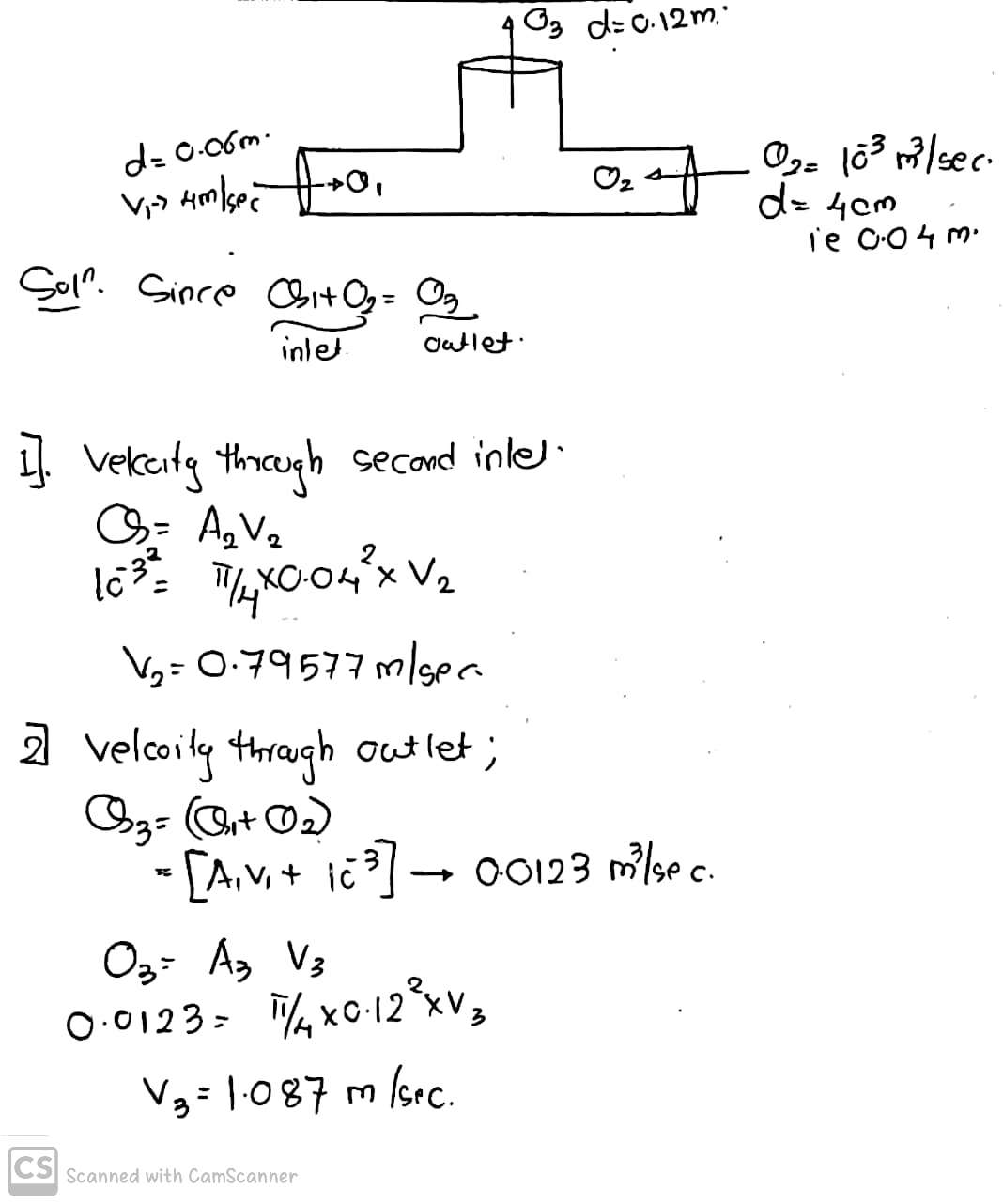A t-joint is another common piping component, typically used to combine or separate flows of fluid. This t-joint has two inlets and one outlet. We want to find the flow rate through the outlet and the force to hold the t-joint in place. The working fluid is water. One inlet, open to the left, is 6 cm diameter and receives water at a velocity of 4 m s-¹. The other inlet, open to the right, has a volume flow rate of 1 Ls¹ and a diameter of 4 cm. If the outlet has a diameter of 12 cm and faces upwards with regard to gravity, determine: (a) the velocity through the second inlet. [0.80 m s-¹] (b) the velocity through the outlet. [1.09 m s-¹] (c) the reaction forces (x, y directions) to hold the t-joint in place [x: -181.7 N, y: 1156 N] Losses due to viscosity are assumed negligible. The outlet discharges to atmosphere. The weight of the t-joint and the fluid within it are negligible.
A t-joint is another common piping component, typically used to combine or separate flows of fluid. This t-joint has two inlets and one outlet. We want to find the flow rate through the outlet and the force to hold the t-joint in place. The working fluid is water. One inlet, open to the left, is 6 cm diameter and receives water at a velocity of 4 m s-¹. The other inlet, open to the right, has a volume flow rate of 1 Ls¹ and a diameter of 4 cm. If the outlet has a diameter of 12 cm and faces upwards with regard to gravity, determine: (a) the velocity through the second inlet. [0.80 m s-¹] (b) the velocity through the outlet. [1.09 m s-¹] (c) the reaction forces (x, y directions) to hold the t-joint in place [x: -181.7 N, y: 1156 N] Losses due to viscosity are assumed negligible. The outlet discharges to atmosphere. The weight of the t-joint and the fluid within it are negligible.
Elements Of Electromagnetics
7th Edition
ISBN:9780190698614
Author:Sadiku, Matthew N. O.
Publisher:Sadiku, Matthew N. O.
ChapterMA: Math Assessment
Section: Chapter Questions
Problem 1.1MA
Related questions
Question

Transcribed Image Text:**Understanding T-Joints in Fluid Mechanics**
A T-joint is a common piping component used to combine or separate fluid flows. In this educational example, we explore a T-joint with two inlets and one outlet to determine the flow rate through the outlet and the forces necessary to hold the T-joint in place. The working fluid in this scenario is water.
**System Details:**
- **Inlet 1:** Located to the left, with a diameter of 6 cm, allowing water in at a velocity of \(4 \, \text{m/s}\).
- **Inlet 2:** Located to the right, this inlet has a volume flow rate of \(1 \, \text{L/s}\) and a diameter of 4 cm.
- **Outlet:** With a diameter of 12 cm, it faces upwards against gravity.
**Objectives:**
1. **Velocity through the second inlet:**
- Calculated velocity: \(0.80 \, \text{m/s}\)
2. **Velocity through the outlet:**
- Calculated velocity: \(1.09 \, \text{m/s}\)
3. **Reaction Forces:**
- Forces needed to hold the T-joint in place are calculated in both x and y directions:
- \(x\)-direction: \(-181.7 \, \text{N}\)
- \(y\)-direction: \(1156 \, \text{N}\)
**Key Assumptions:**
- Viscosity losses are negligible.
- The outlet discharges to the atmosphere.
- The weight of both the T-joint and the fluid within it is negligible.
This analysis provides insights into fluid dynamics principles and showcases the importance of understanding flow rates and force calculations in piping systems.
Expert Solution
Step 1: Velocity through the second inlet and the outlet

Trending now
This is a popular solution!
Step by step
Solved in 3 steps with 2 images

Knowledge Booster
Learn more about
Need a deep-dive on the concept behind this application? Look no further. Learn more about this topic, mechanical-engineering and related others by exploring similar questions and additional content below.Recommended textbooks for you

Elements Of Electromagnetics
Mechanical Engineering
ISBN:
9780190698614
Author:
Sadiku, Matthew N. O.
Publisher:
Oxford University Press

Mechanics of Materials (10th Edition)
Mechanical Engineering
ISBN:
9780134319650
Author:
Russell C. Hibbeler
Publisher:
PEARSON

Thermodynamics: An Engineering Approach
Mechanical Engineering
ISBN:
9781259822674
Author:
Yunus A. Cengel Dr., Michael A. Boles
Publisher:
McGraw-Hill Education

Elements Of Electromagnetics
Mechanical Engineering
ISBN:
9780190698614
Author:
Sadiku, Matthew N. O.
Publisher:
Oxford University Press

Mechanics of Materials (10th Edition)
Mechanical Engineering
ISBN:
9780134319650
Author:
Russell C. Hibbeler
Publisher:
PEARSON

Thermodynamics: An Engineering Approach
Mechanical Engineering
ISBN:
9781259822674
Author:
Yunus A. Cengel Dr., Michael A. Boles
Publisher:
McGraw-Hill Education

Control Systems Engineering
Mechanical Engineering
ISBN:
9781118170519
Author:
Norman S. Nise
Publisher:
WILEY

Mechanics of Materials (MindTap Course List)
Mechanical Engineering
ISBN:
9781337093347
Author:
Barry J. Goodno, James M. Gere
Publisher:
Cengage Learning

Engineering Mechanics: Statics
Mechanical Engineering
ISBN:
9781118807330
Author:
James L. Meriam, L. G. Kraige, J. N. Bolton
Publisher:
WILEY